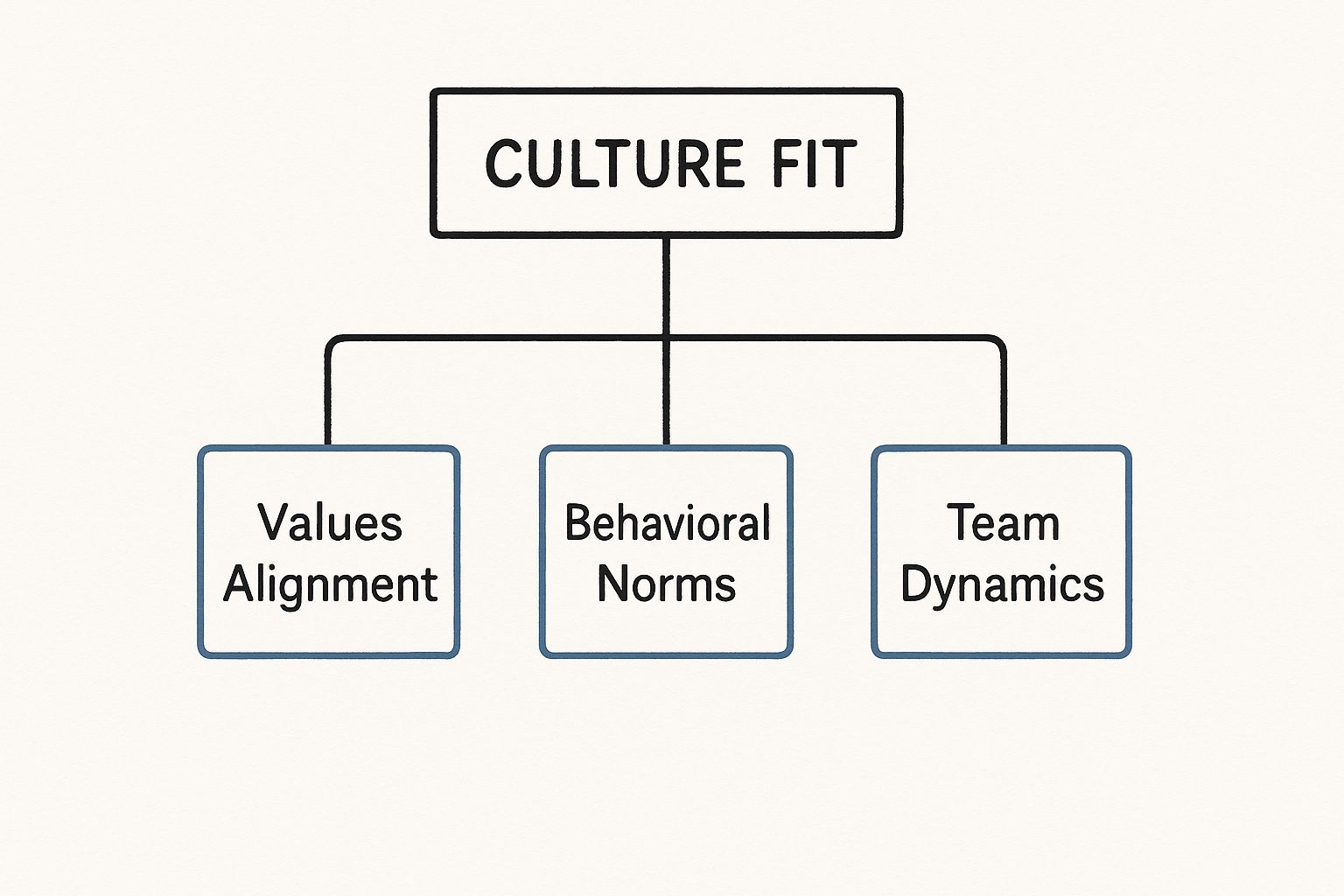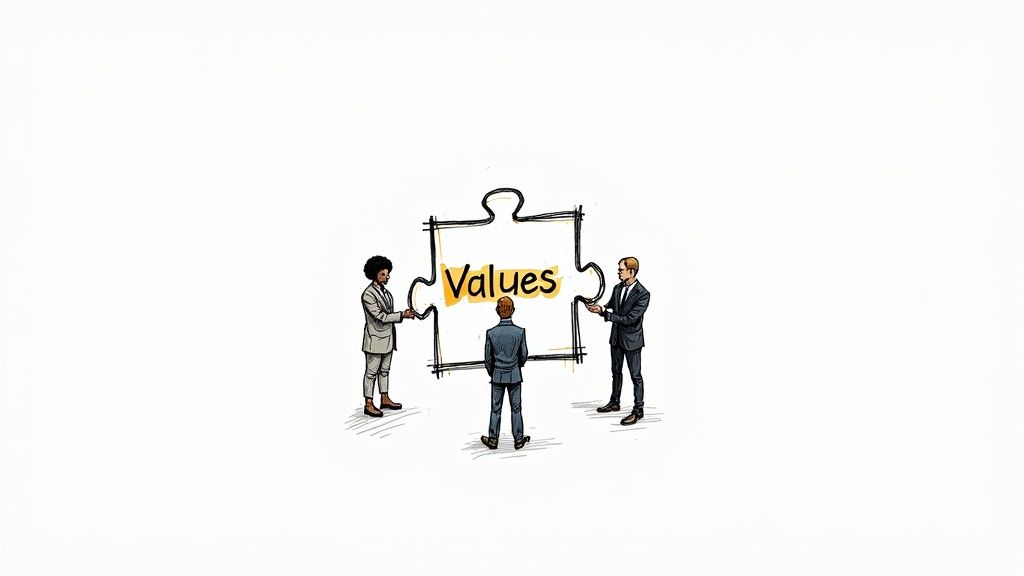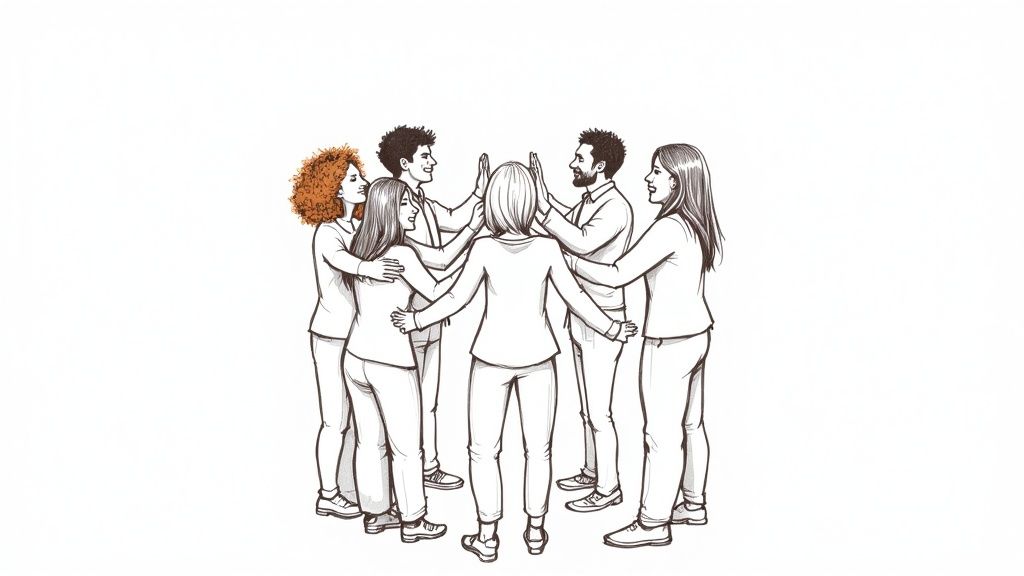Nailing Culture Fit Without Cloning Your Team

It's easy to misunderstand culture fit. It's not about hiring a team of people who all think, act, and look the same. The real goal is to find individuals whose core values and working style genuinely connect with your company's mission and how you operate. Think of it as building a complementary team, not a room full of carbon copies. When you get this right, it has a ripple effect, boosting everything from collaboration to morale and, ultimately, your bottom line.
What Culture Fit Actually Means for Your Business
Let's get one thing straight: culture fit is not a flimsy excuse to hire people you'd enjoy getting a beer with. That’s a common trap, and it’s a dangerous one. When used as a shield for bias, it leads to a workplace full of "culture clones"—a homogenous group where everyone shares the same background and perspective. This kind of environment is a killer for innovation and leaves massive blind spots in your strategy.
A much better analogy for a strong culture fit is a well-conducted orchestra. You wouldn't want an orchestra with 70 violins all playing the exact same note. That would be awful. You need a rich mix of instruments—the deep resonance of cellos, the bright call of trumpets, the steady rhythm of percussion.
Each instrument brings a unique voice, but they are all playing from the same sheet of music. That "sheet music" is your company’s core values and operational DNA. Everyone contributes something different, but they are all working in harmony toward the same beautiful, unified goal.
The Core Components of Culture Fit
To move past "gut feelings" and make culture fit a strategic tool, you have to break it down into its core parts. It’s not some vague, mystical concept; it rests on a few solid pillars.
This graphic really helps visualize how the pieces fit together, showing how a strong fit is built from the ground up, starting with values and flowing into behaviors and team dynamics.

As you can see, it all starts with shared values. Those values then shape the day-to-day behaviors and interactions that define a positive and effective work environment.
Here’s a closer look at what each element means for your organization:
- Values Alignment: This is the bedrock. It's about whether a candidate’s personal principles and motivations genuinely click with your company’s purpose. If you haven't nailed this down yet, our guide on establishing the core values of the business is a great place to start.
- Behavioral Norms: These are the unwritten rules of the road in your workplace. How do people communicate? Is feedback direct and candid, or is it more diplomatic? Do teams collaborate on everything, or is autonomous work the standard?
- Team Dynamics: This is where we shift from "fit" to "add." The real question isn't just "Will they fit in?" but "How will they enhance the team?" The focus should be on finding someone who brings a fresh perspective or a new skill that makes the whole group stronger, rather than just duplicating what you already have.
The Business Case for Getting It Right
The link between culture fit and business success isn't just a feel-good idea; research supports the connection. According to a 2021 study by the Society for Human Resource Management (SHRM), one in five American workers has left a job in the past five years due to poor company culture, at an estimated cost of $223 billion to businesses.
A huge part of this comes down to retention. Research published in the Journal of Applied Psychology indicates that employees who feel they fit well with their organization, coworkers, and supervisor tend to have greater job satisfaction, higher performance, and are more likely to remain with their organization.
A well-defined culture fit strategy acts as a powerful amplifier for performance. When employees feel they belong and are aligned with the company’s purpose, they are more engaged, more collaborative, and more likely to stay long-term.
The Hidden Dangers of Getting Culture Fit Wrong

When the concept of culture fit is misunderstood, it transforms from a powerful team-building tool into a serious business liability. Too often, it becomes a flimsy justification for hiring based on "gut feelings" or looking for people who are just like everyone else on the team. That's a surefire way to build a stagnant, homogenous workforce, and it does real, measurable harm.
Imagine creating an echo chamber. When you only hire people who went to the same schools, enjoy the same hobbies, and come from similar backgrounds, you're not building a dynamic team—you're just building a room full of mirrors. Ideas bounce around, unchallenged and amplified, while unique perspectives are never even heard. This is the fast track to groupthink, and it's where innovation comes to a halt.
This isn't just a theory. Research by McKinsey has consistently shown that companies in the top quartile for ethnic and cultural diversity are 36% more likely to have financial returns above their respective national industry medians. A company that lacks diversity will inevitably struggle to understand and serve a diverse customer base, missing out on entire market opportunities. The real cost is stagnation; the company becomes incapable of adapting simply because it silenced the very people who could have pointed out the need for change.
The Slippery Slope to Unconscious Bias
Perhaps the biggest pitfall of a vague culture fit strategy is that it paves the way for unconscious bias. Even with the best intentions, a hiring manager might gravitate toward a candidate they feel a personal rapport with. This "like-me" bias means they subconsciously favor people who remind them of themselves, which unintentionally disqualifies a massive pool of incredible talent.
This is exactly how you end up with a team that thinks alike, acts alike, and never challenges the status quo. One of the most critical parts of fair hiring involves addressing unconscious bias in recruitment to break this cycle.
When every new hire is a reflection of the existing team, you're not strengthening your culture; you're calcifying it. You create a rigid environment that's resistant to new ideas and incapable of growth.
The damage doesn't stop at hiring, either. A Gallup report revealed that only 33% of U.S. employees feel truly engaged at work. A huge driver of this disengagement is the feeling of not belonging—a direct consequence of cultures where "fit" has been warped to mean "sameness."
From Culture Fit to Culture Clone
The most common mistake we see is companies confusing genuine culture fit with creating "culture clones." They are two completely different things with drastically different results.
- Culture Fit (Shared Values): This is all about alignment on core principles. If one of your company's core values is collaboration, you look for people who genuinely thrive in a team setting, regardless of their background, personality, or interests.
- Culture Clone (Shared Backgrounds): This is hiring based on superficial traits. It's preferring candidates from a specific university, with certain hobbies, or who communicate in the exact same style as everyone else.
Hiring for shared backgrounds is hiring for comfort, not strength. Sure, a team of clones might get along on the surface, but they will almost certainly lack the creative tension required to solve tough problems. For more on this, check out our guide to building culture at work that encourages growth over sameness.
This is why the conversation has shifted toward hiring for culture add. Instead of asking, "Will this person fit in?" a much better question is, "What new perspective, skill, or experience can this person bring to our team?" This mindset proves that diversity and true culture fit aren't at odds—they are essential partners in building a resilient, innovative, and truly successful company.
How to Assess Culture Fit Objectively
Let's be honest: "gut feelings" about candidates are often just unconscious bias in disguise. When we rely on intuition alone, we tend to hire people who look, think, and act just like us. Moving away from that requires a real system—a structured way to measure how a candidate aligns with what your company actually values.
The goal is to build a process that removes personal preference from the equation. It starts with defining what truly matters to your organization and then creating a consistent way to evaluate every single candidate against that very same standard.
Build a Culture Rubric
The first step toward objectivity is to create a Culture Rubric. Think of it as a scorecard for your company's core values. This isn't about an interviewer's personal likes or dislikes; it's a tool tied directly to the essential behaviors that make your company tick. If you haven't clearly defined those values yet, that's where you need to begin.
For instance, let's say one of your core values is "Radical Candor." A rubric helps you define what that looks like in the real world.
- Excellent (5 points): The candidate shares specific stories of giving and receiving direct, constructive feedback, even when it was uncomfortable. They clearly get the balance between caring personally and challenging directly.
- Good (3 points): The candidate agrees that honesty is important but their examples are more general. They seem to understand the concept but might not have put it into practice much.
- Poor (1 point): The candidate seems to avoid conflict, prefers indirect communication, or gets visibly uncomfortable discussing tough feedback.
See the difference? This simple tool transforms an abstract idea into something you can actually measure. You stop asking, "Are they a good fit?" and start asking, "Did they demonstrate the behaviors we associate with radical candor?" It's a fundamental shift from personality to proven action.
Conduct Structured Behavioral Interviews
With your rubric in hand, it's time to gather the evidence. The best way to do this is through structured, behavior-based interviews. Unlike a free-flowing chat that can meander off-topic, this approach ensures every candidate gets the same questions in the same order. It creates a level playing field.
The questions are designed to get people talking about their past actions because past behavior is one of the most reliable predictors of future performance.
According to research from Michigan State University, structured interviews can be up to twice as effective at predicting job performance compared to unstructured interviews. When you standardize your interview process, you reduce the risk of bias and improve your ability to make quality hires.
Here’s how you can frame questions to get at the heart of your values:
| Value to Assess | Example Behavioral Question | What to Look For |
|---|---|---|
| Collaboration | "Tell me about a time you were on a project team with conflicting opinions. How did you navigate that?" | Evidence of active listening, respecting different views, and working to find a constructive way forward. |
| Innovation | "Describe a situation where you challenged the 'way we've always done it.' What was your new approach?" | Curiosity, creative problem-solving, and the resilience to push back against resistance to change. |
| Customer Focus | "Walk me through a time you went above and beyond for a customer. What happened and what was the result?" | Empathy, a powerful sense of ownership, and a focus on long-term satisfaction over a quick fix. |
Shift Your Focus to Culture Add
Ultimately, an objective process isn't just about finding people who fit the mold. The most dynamic, successful teams are built by hiring for culture add. This is a conscious effort to find candidates who bring new perspectives, valuable skills, and different experiences that will enrich your existing culture.
Instead of asking, "Will they be like us?" the more powerful question is, "How will their unique background make us better?"
Hiring for culture add is a deliberate strategy for building a more diverse team where every person contributes something unique. It’s also a powerful method for reducing hiring bias with an evidence-based approach and creating a more inclusive workplace. When you prioritize diversity of thought, innovation stops being a buzzword and becomes a daily reality.
Adapting Culture Fit for a Global Workforce

Let's be honest: a company culture that feels electric in Silicon Valley could fall completely flat in Stockholm. As businesses stretch across the globe, the whole idea of culture fit has to evolve. What we consider "great" communication, a "dedicated" employee, or even a "healthy" work-life balance can change dramatically from one country to the next.
Trying to stamp a rigid, one-size-fits-all culture onto a global team is a surefire way to breed disengagement and frustration. The real secret to succeeding on the world stage isn't about enforcing sameness; it's about cultural intelligence. This means figuring out how to make your core company values resonate within different local contexts. It’s a powerful realization that flexibility isn't just a perk—it’s a basic requirement for building a cohesive and respectful team that spans continents.
Global vs. Local Cultural Norms
Workplace expectations are deeply woven into the fabric of national cultures. For instance, many Scandinavian countries champion a clean break between work and personal life. Adhering strictly to working hours is seen as a sign of efficiency, not a lack of commitment. In contrast, some high-commitment work environments in Asia might interpret long hours as a powerful display of loyalty and dedication.
Neither of these approaches is better than the other—they're just different. A multinational company can't assess culture fit using only its home-office perspective. A candidate in Sweden who prioritizes leaving at 5 p.m. to be with their family isn't lazy; they are simply living by a powerful local norm. Likewise, a candidate in Japan who seems more reserved in meetings isn't unengaged; they are likely showing respect in a culturally appropriate way.
True global culture fit isn't about finding people who will blend into a single corporate mold. It's about discovering individuals who connect with your core values while staying true to their own cultural context. It’s the critical difference between demanding uniformity and nurturing unity.
Getting this right demands a more thoughtful approach, starting with a genuine willingness to listen and adapt. To see how these dynamics unfold in a specific region, check out these excellent insights on what makes for successful remote hiring in Latam.
The Data Behind Global Workplace Culture
While a positive culture boosts employee satisfaction everywhere, the results are anything but uniform. Research from a 2023 SHRM global report drives this point home. It revealed that while 61% of employees worldwide gave their culture a thumbs-up, the regional differences were significant.
Employees in places like India and the UAE reported some of the highest satisfaction levels, whereas those in France and Japan consistently scored lower. More importantly, the report found that people in good cultures were 790% more likely to be satisfied with their jobs and 83% less likely to be looking for a new one. This data confirms the universal power of a strong culture while also highlighting the varied local realities leaders must learn to navigate.
Strategies for a Cohesive Global Team
So, how can you bridge these cultural divides and build a team that feels truly connected? The key is to separate your foundational principles from surface-level practices.
Here’s a practical framework:
Define Your Non-Negotiable Core Values: What are the 3-5 principles that are the absolute bedrock of your company? Think about values like "customer obsession," "unwavering integrity," or a "bias for action." These should be universal truths for your business.
Empower Local Adaptation: While your core values are set in stone, how they are expressed should be flexible. Let your local teams define what "customer obsession" looks like in their market. This gives them a sense of ownership and ensures the value is applied in a way that makes sense locally.
Measure What Matters: To truly understand how your values are being lived out across different regions, you need consistent, reliable data. Our guide on creating an organizational culture survey can show you how to gather the insights needed to make smart, informed decisions.
Promote Cross-Cultural Training: Don't stop at training new hires. Invest in teaching your leaders and existing teams about cultural intelligence. Help them understand different communication styles, attitudes toward hierarchy, and approaches to work-life balance.
By focusing on a shared purpose while respecting local differences, you can build a truly global culture that strengthens your entire organization instead of splintering it.
Why Work-Life Balance Is the New Culture Litmus Test
The whole idea of culture fit is changing. It's not about finding people who all think and act the same anymore. For the most talented people on the job market today, a company's real-world approach to work-life balance has become the ultimate deal-breaker. This isn't just a trend; it's a fundamental shift in what makes a company a great place to work, pushed into high gear by the move to remote and hybrid models.
A company's culture isn't defined by its ping-pong tables or happy hours. It’s revealed in the small, everyday ways it respects its employees' time, autonomy, and well-being. Companies that truly champion a healthy balance don't just come across as more compassionate—they are seen as having a stronger, more resilient culture that the best people want to be a part of.
What Balance Really Looks Like Today
Let's be clear: genuine work-life balance isn't about a perfect 50/50 split of your day. That's a myth. It’s about building an environment rooted in trust, where people feel empowered to do great work without having to sacrifice their personal lives. For many, this has evolved into the idea of work-life integration, where work and life can coexist more fluidly.
Companies that nail this are the ones winning the war for talent. They prove they’re a great fit for the modern professional by offering:
- Real Flexibility: This means more than just a remote work policy. It's about trusting your team to manage their own time and deliver on their goals without someone micromanaging their every move.
- Clear Boundaries: Leaders actively discourage the "always on" mentality. They respect that personal time is exactly that—personal and non-negotiable.
- Holistic Support: They invest in meaningful mental health resources, encourage people to actually take breaks, and have leaders who model this behavior from the top.
A company’s commitment to its people’s well-being is the clearest sign of a healthy, forward-thinking culture. It shows they see employees as whole human beings, not just assets. This is the new gold standard for an authentic culture fit.
How Work-Life Balance Translates Across the Globe
Here’s where it gets tricky for global companies: what’s considered "balanced" in one country can be completely different in another. According to the OECD Better Life Index, countries like the Netherlands and Italy report that very few employees work long hours, while countries like Mexico and Turkey have some of the highest rates of employees working over 50 hours per week.
This contrast highlights how cultural norms shape what "fit" means. In a high-pressure environment, fitting in might mean embracing overtime. In a more egalitarian culture, it means valuing your autonomy and personal time. You can read more about these cultural influences on work-life balance from a cross-continental perspective.
This proves that a one-size-fits-all company culture is destined to fail on a global scale. The most successful modern cultures are adaptable. They find a way to honor local norms while staying true to their core values of respecting their team's well-being. That ability to adapt is the true measure of a healthy, global-ready culture.
Using Technology to Find Your Next Great Hire
Let's be honest, relying on gut feelings to gauge culture fit is a gamble. We've all been there. You have a great conversation with a candidate, they have a solid resume, and you just get a "good vibe." But vibes aren't data, and they can lead to inconsistent, and often biased, hiring decisions.
Modern recruiting technology offers a better way. Think of these platforms not as a replacement for human judgment, but as an incredibly smart co-pilot. They give hiring teams the objective data needed to make the assessment process sharper, quicker, and a whole lot fairer for everyone involved.
By analyzing everything from survey responses to interview transcripts against your company's core values, these tools can spot alignment and flag potential mismatches with surprising accuracy. It’s about making your process more consistent and giving every applicant the same fair shot.
A Data-Driven Approach to Culture
One of the biggest wins of using technology is its power to dial down the unconscious bias that can sneak into even the most well-intentioned hiring process. When every candidate is measured against the same clear benchmarks, things like a shared alma mater or a similar hobby lose their oversized influence.
This data-first mindset keeps the focus exactly where it should be: on a candidate's alignment with your core values and their potential to contribute to your company's culture. And the payoff is huge. A Gallup study found that companies with engaged employees—a direct result of getting the culture piece right—are 23% more profitable than their competitors.
By standardizing how you assess candidates, technology fundamentally changes the question. It’s no longer, "Do I personally like this person?" but rather, "Do this person's values and working style mesh with our company's DNA?"
Here’s a quick look at how a platform like MyCulture.ai visualizes this data, turning abstract ideas into concrete insights.

This kind of dashboard gives you an instant, easy-to-read breakdown of how a candidate stacks up against what your company truly cares about.
Beyond the Resume
A resume only tells you what someone has done, not how they do it or why it matters to them. Technology helps you dig deeper to get a much more complete picture of a candidate. Through tailored assessments, you can finally measure the things that are nearly impossible to quantify otherwise.
- Behavioral Alignment: Does this person thrive in a collaborative buzz, or do they need quiet autonomy to do their best work? Assessments can uncover these critical work-style preferences.
- Value Congruence: You can see how closely a candidate's personal drivers align with your company's mission. This is a powerful predictor of long-term engagement and a strong culture fit.
- Soft Skills: Essential traits like communication, adaptability, and problem-solving can be evaluated in a standardized, consistent way for every applicant.
When you bring these tools into your hiring process, you're doing more than just saving time. You're making a fundamental upgrade to the quality of your hires. You get better data, make fairer decisions, and build a more solid, objective foundation for what is arguably the most important decision any business can make.
Got Questions About Culture Fit? We've Got Answers.
Diving into the world of culture fit can feel a bit murky, and it’s completely normal for questions to pop up. Let's clear the air with some straightforward answers to the common things we hear from hiring managers and HR leaders.
Culture Fit vs. Culture Add: What's the Real Difference?
It’s easy to get these two confused, but they serve different, equally important purposes.
Think of culture fit like finding the perfect puzzle piece. You're looking for someone whose personal values and working style naturally click with your company's existing environment. If your team lives and breathes collaboration, you’d look for a candidate who genuinely lights up when working with others. They fit right in.
Culture add, on the other hand, is about finding a piece that brings something new and exciting to the puzzle. This person introduces a fresh perspective, a unique background, or a skill set your team is missing. It's about consciously building a more dynamic team. And it matters—a 2022 CNBC survey revealed that nearly 80% of employees want to work in a diverse and inclusive company, making culture add a powerful magnet for top talent.
The bottom line? Culture fit creates a strong, unified foundation based on shared values. Culture add builds on that foundation by introducing diverse ideas that spark innovation. The sweet spot is a mix of both.
How Can We Measure This Without Letting Bias Creep In?
This is the million-dollar question. The key is to ditch the "gut feelings" and build a process grounded in solid evidence. It really comes down to a few key actions:
- Nail Down Your Values: Before you can see if someone aligns with your culture, you have to be crystal clear on what that culture is. Write down the specific values and behaviors that make your company tick.
- Use the Same Yardstick for Everyone: Standardized assessments are your best friend here. Using pre-employment tests that evaluate how a candidate’s values, work preferences, and soft skills match up with your company’s profile gives you objective data to work with.
- Structure Your Interviews: Don't just wing it. Create a set of behavioral and situational questions linked directly to your core values and ask every single candidate the same ones. This helps you compare apples to apples instead of relying on personal chemistry.
When you create a consistent, structured process, the focus shifts from superficial traits to what really matters: how a candidate’s past actions and core motivations connect with your company's DNA.
Ready to build a stronger, more aligned team with less bias? MyCulture.ai provides the data-driven tools you need to assess culture fit objectively and make hiring decisions with confidence. Explore how it works.
Article created using Outrank